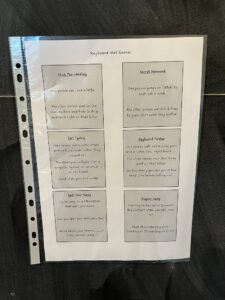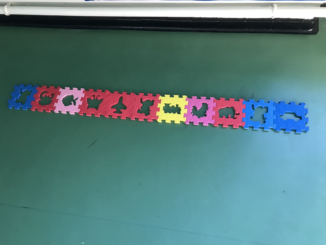As soon as I had a spare moment at my new work (and some spare mats), I made a keyboard mat again like the one I had in England. 😁
I just love so very much all the possibilities it has.

Human bodies learn from big, to small. When children are first learning to form letters*, they make big, clumsy letters on the page or on the easel or on a wall with chalk. (Before that, they should really learn to trace even bigger, giant letters in the air!) Then eventually they learn to make the letters smaller and perhaps within some large-spaced lines…then eventually even smaller, maybe within notebook lines.
*I’m speaking in philosophical ideals here. I’m aware that this often doesn’t happen. I’m saying how they ought to learn, though…the way the progression would take place.
I believe it should be the same for learning typing.
(I’m also seeing a lack of actually teaching typing in schools — a lot of schools seem to use typing games as a “bonus” activity, a thing kids can try if they’ve finished all their other work early. That means that kids who already struggle with academics are fully left in the dust when it comes to computer use and typing, because they never finished their academic things soon enough to get to work on typing, let alone had the mental capacity left over to try to learn a new thing. And that’s on top of the complication of trying to touch type on a touch screen instead of a physical keyboard, when both are still necessary skills in the current world…but I’m digressing.)
Anyway, like I said: I believe it should be the same for learning typing. A common barrier I see with kids I work with, for whom typing would be a MASSIVELY helpful skill to accessing the world, is frustration at a QWERTY keyboard layout because it feels arbitrary and frustrating and maybe letters are a bit tricky for them and so they’re having to hunt and expend mental resources to read each letter looking for the one they need… and it greatly undercuts the ability of typing to be a *support* for them in accessing the world.
So. QWERTY keyboard. Early (no age of kid who can’t play with the keyboard mat if they want); big (jumping size!); and fun. Have I got evidence behind this? Only anecdotal cause I made it up. But it’s been an anecdotal delight in my work in England, so I carried it over here.
Now with added game ideas on the wall just in case anybody needs some game ideas, though the kids often find ways to make stuff up and that works too. Also, this particular one is housed under some monkey bars and I LOVE that. It means you can monkey bar across and then drop onto the letter you’re seeking!

Stick The Landing
One person calls out a letter.
The other person goes on the monkey bars and tries to drop and land right on that letter.
Secret Password
One person jumps on letters to spell out a word.
The other person watches & tries to guess what word they spelled.
Feet Typing
One person jumps onto letters and calls out what letters they jumped on.
The other person types it on a computer, typewriter, or writes it on the board.
Read what your feet wrote!
Keyboard Twister
One person calls out a body part and a letter, like, “right hand, L.” The other person puts that body part on that letter.
See how many you can get at the same time before falling over.
Spell Your Name
Try to jump on all the letters that spell your name.
Can you spell your last name too?
What about your favorite (color, animal, snack…)
Biggest Jump
starting on the letter Q, what’s the furthest letter you can jump to?
What about starting on A? starting on Z? Starting on P? M?



